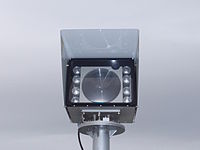Free space optical communications

Okay kiddo, so you know how we use Wi-Fi to connect to the internet? Well, sometimes we can't use Wi-Fi because we're too far from the internet source or there's too much stuff between us and the source, like walls or trees. That's where free space optical (FSO) communications come in!
FSO uses lasers to send information to and from places that are hard to reach with Wi-Fi. Instead of using radio waves like Wi-Fi does, FSO uses light to send the information. It's kind of like using a flashlight to send messages to your friends far away.
The lasers are sent through the air and aimed directly at a reflector or detector, which then sends the information to the internet source or device. This means that there can't be anything blocking the path between the sender and receiver, because the lasers need a clear path to travel.
FSO has some advantages over other forms of communication, like Wi-Fi or cellular networks. It's faster than Wi-Fi and can transmit more information at once. Plus, it uses less energy and doesn't cause interference with other signals in the area.
However, there are some disadvantages too. If it's too foggy, dusty or cloudy, the lasers can't travel very far. Also, the system needs to be aimed very carefully, otherwise the lasers can miss their target and the communication won't work.
Overall, FSO is a cool technology that can help us get internet in places where it's hard to reach.
FSO uses lasers to send information to and from places that are hard to reach with Wi-Fi. Instead of using radio waves like Wi-Fi does, FSO uses light to send the information. It's kind of like using a flashlight to send messages to your friends far away.
The lasers are sent through the air and aimed directly at a reflector or detector, which then sends the information to the internet source or device. This means that there can't be anything blocking the path between the sender and receiver, because the lasers need a clear path to travel.
FSO has some advantages over other forms of communication, like Wi-Fi or cellular networks. It's faster than Wi-Fi and can transmit more information at once. Plus, it uses less energy and doesn't cause interference with other signals in the area.
However, there are some disadvantages too. If it's too foggy, dusty or cloudy, the lasers can't travel very far. Also, the system needs to be aimed very carefully, otherwise the lasers can miss their target and the communication won't work.
Overall, FSO is a cool technology that can help us get internet in places where it's hard to reach.
Related topics others have asked about:
